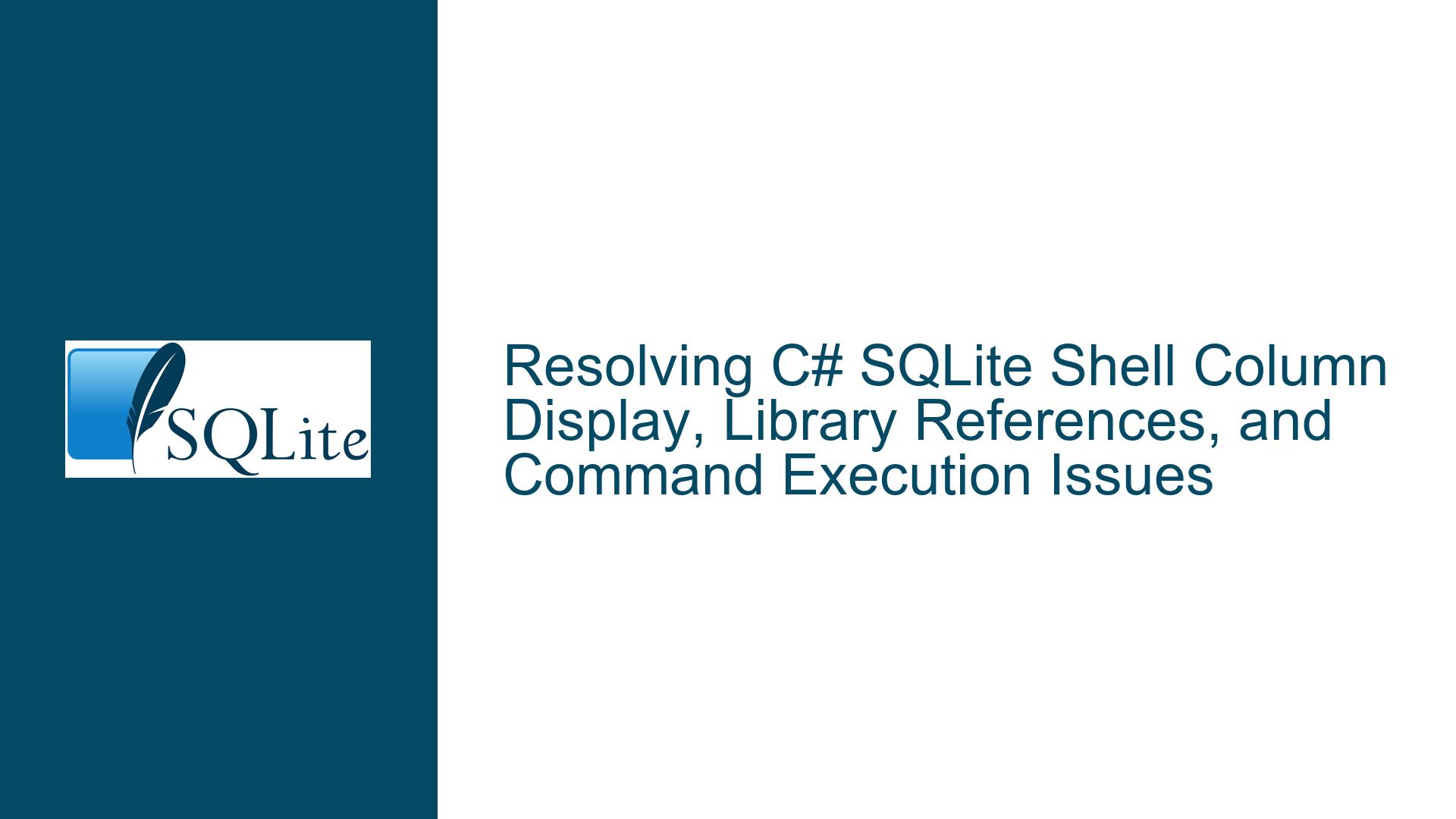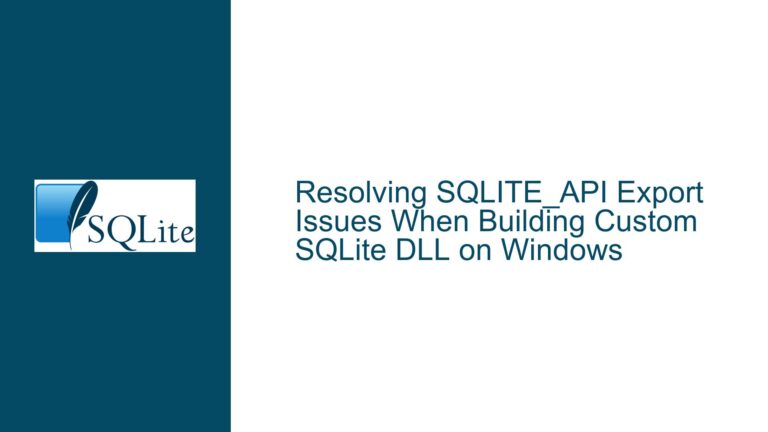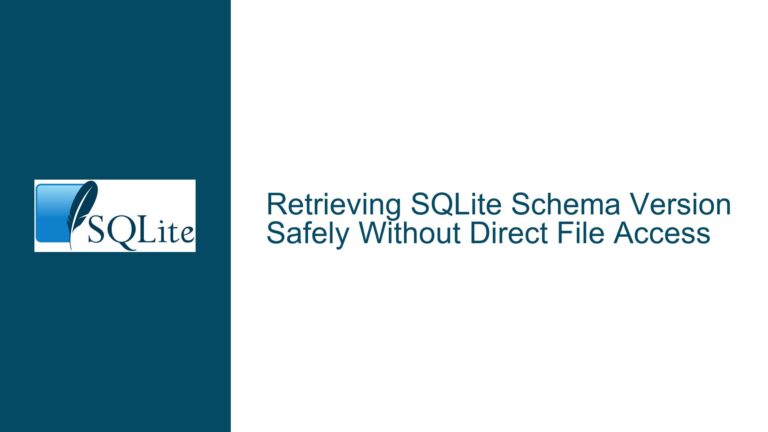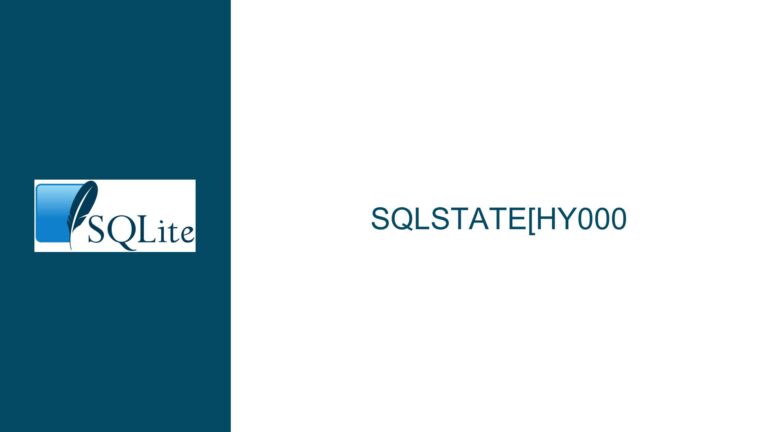Resolving C# SQLite Shell Column Display, Library References, and Command Execution Issues
Issue Overview: Missing Column Headers, Library Compatibility Errors, and Incomplete Command Handling
The provided C# SQLite shell implementation demonstrates foundational interaction with SQLite databases via the Microsoft.Data.Sqlite or System.Data.SQLite libraries. However, three critical limitations emerge during usage:
- Absence of column headers in query results, reducing readability and context for returned data.
- Library reference conflicts between Microsoft.Data.Sqlite and System.Data.SQLite, causing compilation failures or runtime errors due to namespace and class naming discrepancies.
- Incomplete handling of SQL commands, particularly non-query operations (e.g.,
UPDATE,INSERT,DELETE) and multi-statement inputs, leading to silent skips or partial execution.
These issues stem from the code’s simplified structure, which prioritizes minimalism over robustness. The absence of metadata extraction for result sets, inconsistent library bindings, and lack of command-type differentiation create a suboptimal user experience. Additionally, the shell’s inability to process multiple SQL statements per input line diverges from standard SQLite shell behavior, limiting its utility for complex operations.
Possible Causes: Schema Metadata Omission, Namespace Ambiguity, and Command-Type Misuse
1. Column Headers Not Retrieved from Query Result Schemas
The SqliteDataReader exposes column names via the GetName(int index) method and schema metadata through the GetSchemaTable() method. The original code iterates over reader.GetValue(i) to output row values but does not access the reader’s schema data to retrieve column names. This results in output that lacks headers, making it difficult to interpret result sets, especially for ad-hoc queries or unfamiliar tables.
2. Library Compatibility Issues Due to Namespace and Class Name Variations
Two primary SQLite libraries for .NET exist:
- Microsoft.Data.Sqlite: Uses classes prefixed with
Sqlite(e.g.,SqliteConnection). - System.Data.SQLite: Uses classes prefixed with
SQLite(e.g.,SQLiteConnection).
The code’s compilation errors arise when the incorrect library is referenced, as class names and namespaces differ. For example, using SqliteConnection with a reference to System.Data.SQLite.DLL will fail due to a missing type. This ambiguity is exacerbated by incomplete build instructions, leaving developers uncertain about proper dependency management.
3. Command Execution Logic Fails to Distinguish Between Query and Non-Query Operations
The code unconditionally uses ExecuteReader(), which is designed for SELECT statements and other queries returning rows. For non-query commands (e.g., UPDATE, CREATE TABLE), ExecuteNonQuery() is more appropriate, as it returns the number of affected rows instead of a reader. While ExecuteReader() does not throw errors for non-queries, it returns a reader with no rows, causing the while (reader.Read()) loop to skip processing. This creates confusion, as users receive no confirmation of successful non-query execution.
Furthermore, the code processes only the first SQL statement in the input line, ignoring subsequent statements separated by semicolons. This occurs because the input is treated as a single command string, unlike the SQLite3 shell, which splits inputs by semicolons before execution.
Troubleshooting Steps, Solutions & Fixes: Implementing Column Headers, Resolving Library Conflicts, and Enhancing Command Processing
1. Displaying Column Headers in Query Results
Modify the code to extract column names from the SqliteDataReader’s schema before iterating over rows. Insert the following block immediately after command.ExecuteReader() and before while (reader.Read()):
// Print column headers
for (int i = 0; i < reader.FieldCount; i++)
{
Console.Write(reader.GetName(i) + "\t");
}
Console.WriteLine();
This retrieves each column’s name via GetName(i) and prints them in a header row. For better formatting, replace \t with a padding function or use String.PadRight() to align columns.
2. Resolving Library Reference Conflicts
Option 1: Using Microsoft.Data.Sqlite
- Add the NuGet package:
dotnet add package Microsoft.Data.Sqlite --version 8.0.0-preview.5.23280.1 - Ensure the code references
Microsoft.Data.Sqlitewithusing Microsoft.Data.Sqlite;.
Option 2: Using System.Data.SQLite
- Replace all instances of
Sqliteclasses withSQLite(e.g.,SqliteConnection→SQLiteConnection). - Reference
System.Data.SQLite.dllduring compilation:csc Program.cs /reference:"path\to\System.Data.SQLite.dll"
Build Command Examples
- For Microsoft.Data.Sqlite:
csc Program.cs /reference:"%USERPROFILE%\.nuget\packages\microsoft.data.sqlite\8.0.0-preview.5.23280.1\lib\net8.0\Microsoft.Data.Sqlite.dll" - For System.Data.SQLite:
csc Program.cs /reference:"C:\Program Files\System.Data.SQLite\bin\System.Data.SQLite.dll"
3. Handling Non-Query Commands and Multi-Statement Inputs
Differentiating Between Queries and Non-Queries
Replace the unconditional ExecuteReader() with a check for command type:
if (commandText.Trim().ToUpper().StartsWith("SELECT"))
{
using (var reader = command.ExecuteReader())
{
// Print headers and rows
}
}
else
{
int affectedRows = command.ExecuteNonQuery();
Console.WriteLine($"Affected rows: {affectedRows}");
}
This approach is simplistic but flawed, as not all non-SELECT commands are non-queries (e.g., PRAGMA). A better method is to attempt ExecuteReader() first and fall back to ExecuteNonQuery() on error:
try
{
using (var reader = command.ExecuteReader())
{
if (reader.HasRows)
{
// Print headers and rows
}
}
}
catch (SqliteException ex) when (ex.SqliteErrorCode == 1) // SQLITE_ERROR
{
int affectedRows = command.ExecuteNonQuery();
Console.WriteLine($"Affected rows: {affectedRows}");
}
Processing Multiple Statements per Input Line
Split the input by semicolons and execute each statement sequentially:
string[] statements = commandText.Split(new[] { ';' }, StringSplitOptions.RemoveEmptyEntries);
foreach (var statement in statements)
{
using (SqliteCommand cmd = new SqliteCommand(statement.Trim(), connection))
{
// Execute and handle each statement
}
}
4. Additional Improvements
Adding a Console Clear Command
Extend the input check to include a clear command:
if (commandText.ToLower() == "exit")
{
running = false;
}
else if (commandText.ToLower() == "clear")
{
Console.Clear();
}
Handling Parameterized Queries and Transactions
To prevent SQL injection and improve performance, extend the code to support parameters:
// Example: INSERT INTO table VALUES (@param1, @param2)
var parameters = new Dictionary<string, object>();
// Parse commandText to extract parameters (e.g., using regex)
foreach (var param in parameters)
{
command.Parameters.AddWithValue(param.Key, param.Value);
}
Implementing Better Error Messaging
Enhance exception handling to include SQLite error codes and extended information:
catch (SqliteException ex)
{
Console.WriteLine($"SQLite Error {ex.SqliteErrorCode}: {ex.Message}");
}
By systematically addressing these areas, the C# SQLite shell evolves into a robust tool capable of handling diverse SQL operations, providing clear output, and avoiding common library integration pitfalls. Developers can further extend this foundation with features like transaction control, batch imports, or output redirection to meet specific needs.






